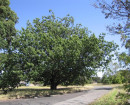ROYAL STANDARD WORKINGS & BATTERY SITE
ROYAL STANDARD SPUR WOODS POINT, MANSFIELD SHIRE
-
Add to tour
You must log in to do that.
-
Share
-
Shortlist place
You must log in to do that.
- Download report


Statement of Significance
What is significant?
The Royal Standard Gold Battery Site consists of the remains of three 5-head stamp batteries, waterwheel, two Cornish boilers, metal chimney flue, and equipment for working an inclined tramway. The battery, boilers and waterwheel, etc., are remnants of crushing facilities put in to serve mines working along Standers Creek. The site is badly obscured by blackberry bushes.
How is it significant?
The Royal Standard Gold Battery Site is of historical, and scientific importance to the State of Victoria.
Why is it significant?
The Royal Standard Gold Battery Site is historically and scientifically important as a characteristic and well preserved example of an important form of gold mining. Although the battery has collapsed, the machinery has not been significantly scavenged. Gold mining sites are of crucial importance for the pivotal role they have played since 1851 in the development of Victoria. As well as being a significant producer of Victoria's nineteenth century wealth, with its intensive use of machinery, played an important role in the development of Victorian manufacturing industry. The abandoned mining machinery at the Morning Star battery site is historically important for its evocation of the adventurousness, hardship, and isolation that was part of mining life in the high country areas of the State.
The Royal Standard Gold Battery Site is archaeologically important for its potential to yield artefacts and evidence which will be able to provide significant information about the technological history of gold mining.
[Source: Victorian Heritage Register]
-
-
ROYAL STANDARD WORKINGS & BATTERY SITE - History
Heritage Inventory History of Site:
The Royal Standard Reef was discovered in 1865, giving the appearance of 'by far the richest vertical reef found in the Wood's Point district'. Early in 1866, the Royal Standard Co. installed a water-powered battery of 15 heads, and their first crushing yielded almost 3,000 oz, averaging more than 9 oz to the ton. Over the ensuing six months, the yield dropped to 2½ oz per ton, a circumstance which the mining registrar attributed in part to 'a probably extensive abstraction of specimens by an organised number of men, who have been watched for some time and were caught in the act. In consequence of this discovery,' he went on, 'the whole of the Cornish men, and the underground manager have been dismissed from the claim.' But the yield from the Royal Standard mine continued to plummet, to an average of 14 dwt per ton early in 1867, falling to just 5 dwt by year's end. Soon after, production was at a standstill, and the mine was let on tribute.
Early in 1867, five more stampers had been added to the battery, along with a steam engine as a supplementary power source. In 1868, the battery was leased for a short time to the nearby Oriental Co. Adjoining the Royal Standard Co.'s ground, a 'floating reef' was struck by the Strap & Buckle Co. in 1869, and gave an impressive trial crushing. Its promise was shortlived, though. By mid-1870, the Royal Standard and Strap & Buckle were giving only poor returns. The Royal Standard Co.'s continued prospecting had shown up nothing worth working, and it leased ten of its stampers to the Golden Star Co., which was prospecting new ground adjoining the Oriental. In 1871, the Oriental Co., after a 'protracted and unpromising' career, finally struck good stone, and was, at that time, the only mine on Stander's Creek giving returns of any sort. The battery 'known as late the property of the Royal Standard Company' was in need of repair, and the Oriental tributers chose to instead tram their stone to the battery of the Champion Co. The Royal Standard battery's state of disrepair was blamed for the poor state of mining on the Black River (Stander's Creek) reefs. The Golden Star, Strap & Buckle, and Oriental companies struggled on until 1873, after which the mining registrar wrote, 'The mines at the Royal Standard are all but abandoned, the number of miners being reduced to three.' (The name 'the Royal Standard' by this time designated a vicinity rather than a mine and had become synonymous with the name 'Black River'.) There was talk of amalgamations, but none appear to have transpired.
In 1875, the Oriental was reborn as the Mountaineer. At that time, Stackpoole and party (tributers at the Morning Star mine, Wood's Point) were pioneering a new method of quartz mining. The method entailed sluicing away the face of the dyke, and then 'saving what loose gold there may be by the usual sluice-box with false bottom, running all solid rock into a paddock of which the fence acts as a grill, screening in pebbles and stones exceeding three inches; these are forked and hand-picked roughly, so as to exclude barren blocks of granite, &c., and the residue, chiefly made up of quartz and veined granite stones, is trucked to the battery and crushed.' This was seen as an inexpensive way of operating upon large bodies of stone, and was soon after adopted at the Mountaineer. A race was cut to increase the available water power. But neither that nor conventional mining methods could wring a payable result from the mine.
Since 1876, the party of McGregor & Mulholland had been engaged in 'long and arduous' prospecting at the Royal Standard. In 1879, they got fair prospects from ground near the Mountaineer. A water-powered battery was ready in time for the first rains of 1881, but poor yields resulted. Prospecting and small-scale working continued in that claim and the Mountaineer workings until 1886, when the claim of McGregor & Mulholland was sometimes known as the Fixed Star. William Wye's new 'loaming' technique of prospecting was, at that time, given its first trial on the Wood's Point goldfield - in the Black River/Royal Standard vicinity. New discoveries resulted, but progress was stymied by the absence of crushing machinery, indicating that the Royal Standard machinery had by that time been removed or was beyond repair. In 1907, a new Royal Standard Co. was formed to work the old Royal Standard mine, and a 10-head battery was installed.
References:
Milner, p. 16
Mining Surveyors' Reports (Woods Point Division), March & June 1865, March, June & December 1866, March 1867, September & December 1868, September 1869, June & September 1870, March & June 1871, December 1873, March 1874, June 1875, June & December 1876, June 1877, June & September 1879, June & December 1880, March 1881, June & December 1886Heritage Inventory Description
ROYAL STANDARD WORKINGS & BATTERY SITE - Heritage Inventory Description
Features at the Royal Standard Reef are extensive mine workings, a tramway formation, remains of a battery, and the remains of buildings.
Heritage Inventory Significance: state
Heritage Inventory Key Components: Workings - on the Royal Standard Spur, to the south and west of Standers Creek, is a substantial open cut. Extending generally northwards from this open cut, and all the way down to the level of the creek, is a series of adits and shafts, many of them still accessible (workings of the Strap and Buckle, 3 adits; Oriental/Mountaineer, 6 adits and 1 shaft; Mulholland, 3 adits and an open stope). In the gully below the middle level workings of the Oriental mine is a substantial dam, several worn drill bits, sections of rails, truck wheels and other pieces of ironwork and, on the opposite side, a quartz track which connects around the slope to an inclined tramway formation. Battery site - north-east from the Royal Standard open cut, and running approximately due north down a small spur between two gullies, is a self-acting tramway formation. This terminates just above the creek at a machinery site which contains the remains of three 5-head stamp batteries, the hub and broken shrouding of a waterwheel, two Cornish boilers (one made by A. Roberts & Sons, Bendigo), a metal chimney flue, some steam engine components, and equipment for working the tramway. Building sites - on the slope above the battery site, on the same side of the creek, are the remains of a rubble masonry chimney which probably formed part of the battery manager's house. A dray track formation leads from the rear of the rubble masonry chimney east along the creek, along which area a number of rubble chimneys, about 100 m from the manager's house. About halfway up the tramway formation are sections of cable and a small assortment of metal fittings from ore trucks. On the east side of the creek, and just below the battery site, is a platform constructed of rubble masonry which probably marks the site of another building.
-
-
-
-
-
ROYAL STANDARD GOLD BATTERY SITE
 Victorian Heritage Register H1270
Victorian Heritage Register H1270 -
CHAMPION WORKINGS & BATTERY SITE
 Victorian Heritage Inventory
Victorian Heritage Inventory -
ROBERT BURNS WORKINGS & BATTERY SITE
 Victorian Heritage Inventory
Victorian Heritage Inventory
-
-







